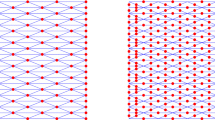Abstract
We investigate the piecewise linear nonconforming Crouzeix–Raviart and the lowest order Raviart–Thomas finite-element methods for the Poisson problem on three-dimensional anisotropic meshes. We first give error estimates of the Crouzeix–Raviart and the Raviart–Thomas finite-element approximate problems. We next present the equivalence between the Raviart–Thomas finite-element method and the enriched Crouzeix–Raviart finite-element method. We emphasize that we do not impose either shape-regular or maximum-angle condition during mesh partitioning. Numerical results confirm the results that we obtained.



Similar content being viewed by others
Notes
Note added in proof. [16,Theorem 2] is incorrect. See the erratum in https://arxiv.org/abs/2002.09721
References
Acosta, G., Durán, R.G.: The maximum angle condition for mixed and nonconforming elements: Application to the Stokes equations. SIAM J. Numer. Anal 37, 18–36 (1999)
Apel, T.H.: Anisotropic finite elements: Local estimates and applications. Advances in Numerical Mathematics. Teubner, Stuttgart (1999)
Arnord, D.T., Brezzi, F.: Mixed and nonconforming finite element methods: Implementation, postprocessing and error estimates. ESAIM 19, 7–32 (1985)
Babuška, I., Aziz, A.K.: On the angle condition in the finite element method. SIAM J. Numer. Anal. 13, 214–226 (1976)
Boffi, D., Brezzi, F., Demkowicz, L.F., Durén, R.G., Falk, R.S., Fortin, M.: Mixed Finite Elements, Compatibility Conditions, and Applications: Lectures Given at the C.I.M.E Summer School, Italy, 2006. Lecture Notes in Mathematics. Springer, Berlin (2008)
Boffi, D., Brezzi, F., Fortin, M.: Mixed Finite Element Methods and Applications. Springer Verlag, New York (2013)
Braess, D.: Finite elements theory, fast solvers, and application in solid mechanics, 3rd edn. Cambridge University Press, Cambridge (2007)
Brenner, S.C.: Forty years of the Crouzeix-Raviart element. Numer. Methods Partial Differ. Equ. 31, 367–396 (2015)
Brenner, S.C., Scott, L.R.: The Mathematical Theory of Finite Element Methods, 3rd edn. Springer Verlag, New York (2008)
Ern, A., Guermond, J.L.: Theory and Practice of Finite Elements. Springer Verlag, New York (2004)
Girault, V., Raviart, P.A.: Finite Element Methods for Navier-Stokes Equations. Springer-Verlag, New York (1986)
Grisvard, P.: Elliptic Problems in Nonsmooth Domains. SIAM, New York (2011)
Gudi, T.: A new error analysis for discontinuous finite element methods for linear elliptic problems. Math. Comp. 79, 2169–2189 (2010)
Hu, J., Ma, R.: The enriched Crouzeix-Raviart elements are equivalent to the Raviart-Thomas elements. J. Sci. Comput. 63, 410–425 (2015)
Ishizaka, H., Kobayashi, K., Tsuchiya, T.: General theory of interpolation error estimates on anisotropic meshes. Jpn. J. Ind. Appl. Math. (to appear). See also Erratum in arxiv.org/abs/2002.09721
Keast, P.: Moderate-degree tetrahedral quadrature formulas. Comput. Methods Appl. Mech. Eng. 55(3), 339–348 (1986)
Kikuchi, F., Saito, N.: Principle of Numerical Analysis (in Japanese). Iwatani-Shoten, Osaka (2016)
Kobayashi, K., Tsuchiya, T.: Error analysis of Crouzeix-Raviart and Raviart-Thomas finite element methods. Jpn. J. Ind. Appl. Math. 35, 1191–1211 (2018)
Liu, X., Kikuchi, F.: Estimation of error constants appearing in non-conforming linear triangular finite element, Proceedings of APCOM’07-EPMESC XI (2007)
Liu, X., Kikuchi, F.: Explicit estimation of error constants appearing in non-conforming linear triangular finite element method. Appl. Math. 63, 381–397 (2018)
Marini, L.D.: An inexpensive method for the evaluation of the solution of the lowest order Raviart-Thomas mixed method. SIAM J. Numer. Anal. 22, 493–496 (1985)
Mario, B.: A note on the Poincaré inequality for convex domains. Z. Anal. ihre. Anwend. 22, 751–756 (2003)
Payne, L.E., Weinberger, H.F.: An optimal Poincaré-inequality for convex domains. Arch. Rational Mech. Anal. 5, 286–292 (1960)
Stroud, A.H.: Approximate Calculation of Multiple Integrals. Prentice-Hall, New Jersey (1971)
Acknowledgements
This work was supported by JSPS KAKENHI Grant Number JP16H03950. We would like to thank the anonymous referee for the valuable comments.
Author information
Authors and Affiliations
Corresponding author
Additional information
Publisher's Note
Springer Nature remains neutral with regard to jurisdictional claims in published maps and institutional affiliations.
About this article
Cite this article
Ishizaka, H., Kobayashi, K. & Tsuchiya, T. Crouzeix–Raviart and Raviart–Thomas finite-element error analysis on anisotropic meshes violating the maximum-angle condition . Japan J. Indust. Appl. Math. 38, 645–675 (2021). https://doi.org/10.1007/s13160-020-00455-7
Received:
Revised:
Accepted:
Published:
Issue Date:
DOI: https://doi.org/10.1007/s13160-020-00455-7



